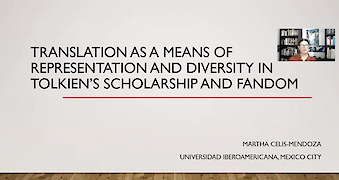
Translation as a means of representation and diversity in Tolkien’s scholarship and fandom
— Martha Celis Mendoza, independent scholar
Paper given 4 July 2021 at Tolkien Society Summer Seminar 2021: Sunday session № 2
Thanks to translation, the works of J.R.R. Tolkien have reached a readership of millions in more than 50 languages. Naturally, the majority of the editions published in languages other than English belong to The Hobbit and The Lord of the Rings. When we reach The Silmarillion, the list of languages starts slimming until gets very thin when dealing with lesser-known works, not to speak of Tolkien’s own translation of Beowulf or Sir Gawain. The same happens regarding Tolkien’s criticism, which rarely gets translated into other languages, based on the partial misconception that all scholars of an English language author must be proficient enough, not only to read their work, but also all the major works of criticism around it. In Mexico, the official language is Spanish, the language of colonization, but there are over 60 Mexican languages with over 300 dialect variations, and Tolkien’s works do not exist in any of them yet; and the same can be said about African languages, and many more. A more dialectic relationship must be promoted, since the works of fiction inspired by Tolkien’s works, and especially academic research and criticism works written in other languages rarely reach English-speaking fandom and scholars. The existence of a language implies the existence of a unique set of concepts and an entirely distinct worldview. The readers that belong to those unique cultures and traditions are missing most of Tolkien’s universe and great linguistic richness while, at the same time, the English-speaking world is missing most of the contributions that are being made in other languages, but many steps can be taken to reduce that gap by means of translation.
❧